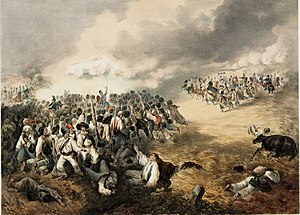This article may require copy editing for Many verb tense errors. (December 2023) |
| Battle of Kisegyes | |||||||
|---|---|---|---|---|---|---|---|
| Part of the Hungarian Revolution of 1848 | |||||||
 Battle of Kishegyes 14 July 1849 | |||||||
| |||||||
| Belligerents | |||||||
|
| |||||||
| Commanders and leaders | |||||||
|
|
| ||||||
| Strength | |||||||
|
Total: 8,360 + ? (61 infantry companies, 14 cavalry companies) 46 cannons Did not participate: 6,603 (37 infantry companies, 8 cavalry companies) 17 cannons |
17,994 men (112 infantry companies, 30 cavalry companies) 73 cannons | ||||||
| Casualties and losses | |||||||
|
Total: 226 81 dead, 145 wounded |
Total: 985 164 dead, 473 wounded, 348 missing and captured[1] | ||||||
The Battle of Kishegyes (now Mali Iđoš, Vojvodina, Serbia) was a battle in the Hungarian Revolution of 1848. It was fought between the Hungarian Revolutionary Army and the Habsburg Corps from July 11 to 15, 1849. The Hungarian Revolutionary Army was under the command of Antal Vetter and Richard Guyon, while the Habsburg Corps was under the Ban of Croatia's Lieutenant Field Marshal, Josip Jelačić, in alliance with the Croatian and Serbian units. Jelačić, wanting to surprise the Hungarians with a night attack, accidentally ran into their positions. Soon afterwards, Hungarian troops attacked Jelačić's army, defeating it and forcing it to retreat to the Titel plateau, which was fortified by the Serbians. As a result, the Hungarian forces retook regions from Bácska, lost after the Battle of Káty, and gained territory back after the initiative on the Southern front.
- ^ Hermann 2004, pp. 319.
